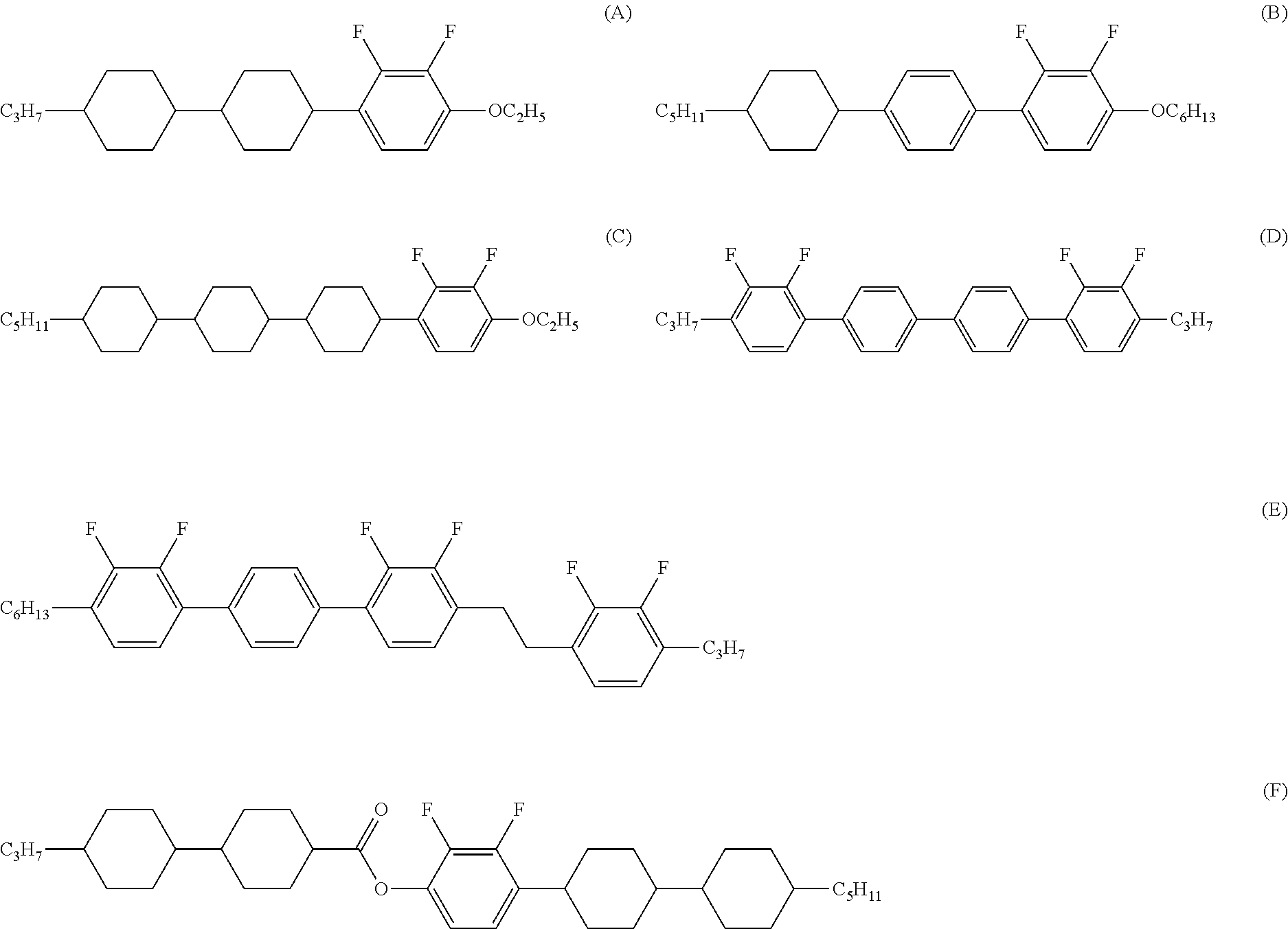Five-ring compound, liquid crystal composition and liquid crystal display device
a technology of liquid crystal compound and liquid crystal composition, which is applied in the direction of instruments, organic chemistry, chemistry apparatus and processes, etc., can solve the problems of compound not having such a large negative dielectric anisotropy that satisfied market demand, compound not having such a large negative dielectric anisotropy that can solve market demand, etc., to achieve large optical anisotropy, large heat stability stability
- Summary
- Abstract
- Description
- Claims
- Application Information
AI Technical Summary
Benefits of technology
Problems solved by technology
Method used
Image
Examples
example 1
Preparation of trans-4-((trans-4′-(4-butoxy-2,3-difluorophenyl)bicyclohexane)-4-yl)methoxy-2,2′,3,3′-tetrafluoro-4′-hexyloxybiphenyl (No. 138)
[0188]
First Step:
[0189]4-Hexyloxy-2,3-difluorophenylboronic acid (s-1) (30.0 g), 4-bromo-2,3-difluorobenzoxybenzene (s-2) (31.6 g), potassium carbonate (43.8 g), Pd(PPh3)2Cl2 (2.2 g), triphenylphosphine (1.7 g), tetrabutylammonium bromide (20.4 g), toluene (200 ml), Solmix A-11 (200 ml) and water (200 ml) were put in a reaction vessel and the mixture was heated to reflux for 2 hours under an atmosphere of nitrogen. After the reaction mixture had been cooled to 25° C., it was poured into water (200 ml) and toluene (200 ml), and mixed with them. The mixture was then allowed to stand until it had separated into two phases of organic and aqueous phases, and the extraction was carried out. The combined organic phase was washed with water and dried over anhydrous magnesium sulfate. The solution was concentrated under reduced pressure and the resulti...
example 2
Preparation of 1-butoxy-4-(trans-4-(trans-4-((trans-4-(2,3-difluoro-4-(hexyloxy)phenyl)cyclohexyl)methoxy)-2,3-difluorophenyl)cyclohexyl)-2,3-difluorobenzene (No. 218)
[0201]
First Step:
[0202]3-Hexyloxy-1,2-difluorobenzene (s-11) (100 g) and THF (1000 ml) were put in a reaction vessel under an atmosphere of nitrogen and cooled to −74° C. sec-Butyllithium (a 1.00 M solution in n-hexane and cyclohexane; 500 ml) was added dropwide thereto in the temperature range of −74° C. to −70° C., and the stirring was continued for another 2 hours. Then, 1,4-dioxaspiro[4.5]decan-8-one (s-12) (72.9 g) in a THF (200 ml) solution was added dropwise thereto in the temperature range of −75° C. to −70° C., and the stirring was continued for another 8 hours while the mixture was allowed to come to 25° C. The reaction mixture was poured into a vessel containing an aqueous solution of ammonium chloride (3%; 500 ml) and ethyl acetate (500 ml), and mixed with them. The mixture was then allowed to stand until i...
example 3
Preparation of 1-butoxy-4-(4-(4-(4-(2,3-difluoro-4-hexyloxyphenyl)cyclohex-1-enyl)-2,3-difluorophenyl)cyclohex-1-en yl)-2,3-difluorobenzene (No. 48)
[0215]
First Step:
[0216]1-Butoxy-4-(4-(2,3-difluorophenyl)cyclohex-1-enyl)-2,3-difluorobenzene (s-20) (8.1 g) and THF (200 ml) were put in a reaction vessel under an atmosphere of nitrogen and cooled to −74° C. sec-Butyllithium (a 1.00 M solution in n-hexane and cyclohexane; 26.0 ml) was added dropwise thereto in the temperature range of −74° C. to −70° C., and the stirring was continued for another 2 hours. Then, 4-(2,3-difluoro-4-hexyloxyphenyl)cyclohexanone (s-14) (20.0 g) dissolved in THF (100 ml) was added dropwise thereto in the temperature range of −75° C. to −70° C., and the stirring was continued for another 8 hours while the mixture was allowed to come to 25° C. The reaction mixture was poured into a vessel containing an aqueous solution of ammonium chloride (3%; 100 ml) and ethyl acetate (100 ml), and mixed with them. The mixtu...
PUM
| Property | Measurement | Unit |
|---|---|---|
| temperature | aaaaa | aaaaa |
| temperature | aaaaa | aaaaa |
| thickness | aaaaa | aaaaa |
Abstract
Description
Claims
Application Information
 Login to View More
Login to View More - R&D
- Intellectual Property
- Life Sciences
- Materials
- Tech Scout
- Unparalleled Data Quality
- Higher Quality Content
- 60% Fewer Hallucinations
Browse by: Latest US Patents, China's latest patents, Technical Efficacy Thesaurus, Application Domain, Technology Topic, Popular Technical Reports.
© 2025 PatSnap. All rights reserved.Legal|Privacy policy|Modern Slavery Act Transparency Statement|Sitemap|About US| Contact US: help@patsnap.com



